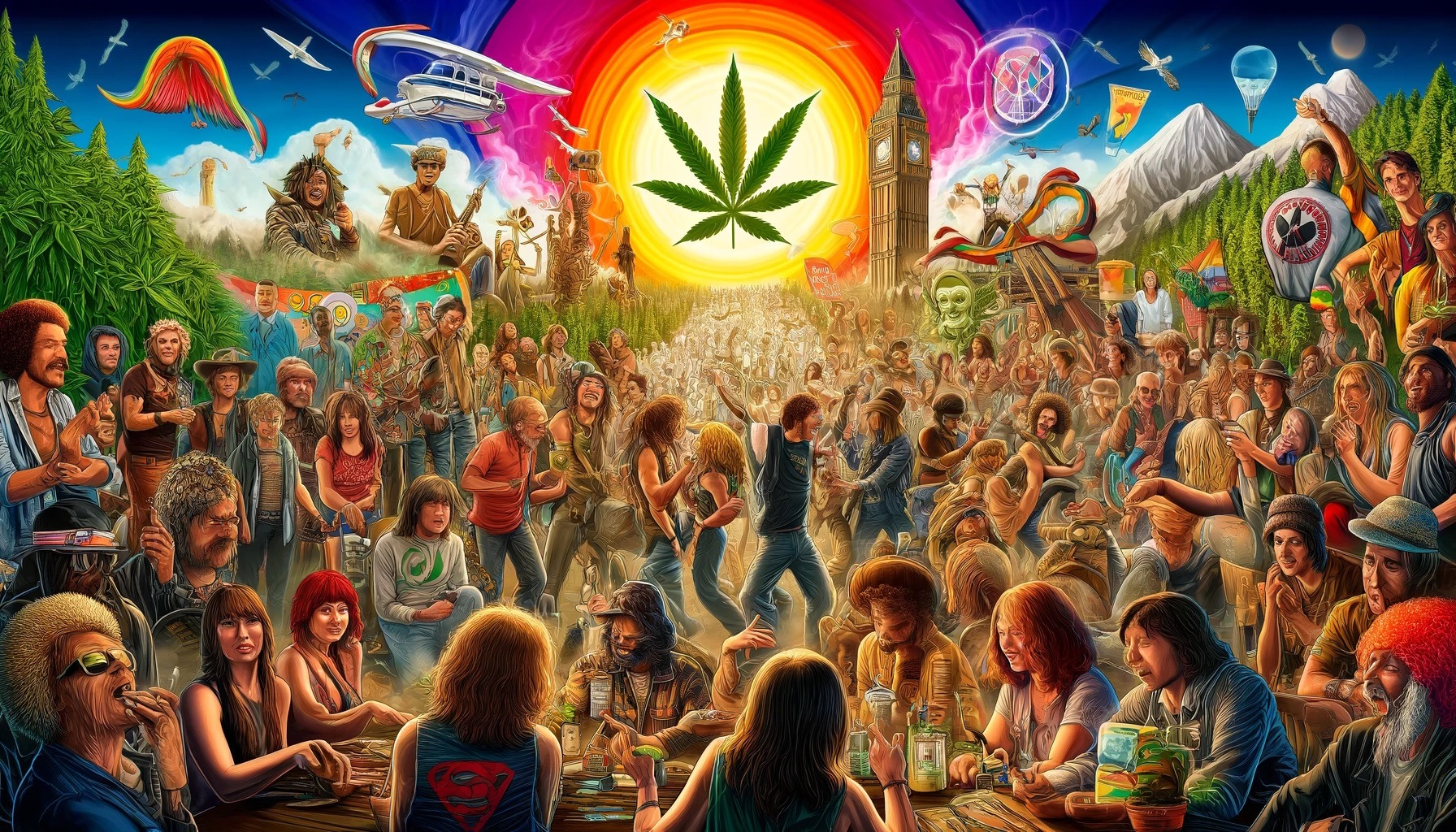Stoners through generations: how 420 has shaped counterculture movements
Marijuana has been a constant in the lives of many people who identify with countercultural movements throughout history. From the hippies of the 1960s to today’s cannabis culture, the use and promotion of weed has been a rallying cry for generations of rebels who reject mainstream society’s norms and values.
The term “420” originated in California during the 1970s as a code word for marijuana usage, with April 20th (4/20) becoming an unofficial holiday for stoners worldwide. Today, the concept of 420 has evolved into a symbol of rebellion and resistance against conservative attitudes towards drugs and other forms of self-expression.
The History of Stoner Culture
Stoner culture can be traced back to the countercultural movements of the 1960s, when marijuana use became popularized by artists, musicians, and activists who rejected traditional values and embraced a more free-spirited lifestyle. The hippie movement was heavily influenced by the use of psychedelic drugs like LSD and cannabis, which were seen as tools for self-exploration and personal growth.
The 1970s saw the emergence of hard rock bands like Led Zeppelin and Black Sabbath who celebrated marijuana usage in their lyrics and stage performances. The heavy metal subculture that grew from these bands also embraced stoner culture, with fans dressing up as devil worshippers and smoking weed during concerts.
The 1990s saw the rise of a new generation of stoners who were influenced by hip-hop music and culture. Rappers like Snoop Dogg and Wiz Khalifa popularized marijuana usage in their lyrics and lifestyles, while movies like Half Baked and Pineapple Express celebrated the antics of stoned characters.
Today’s Cannabis Culture
Today, cannabis culture is more mainstream than ever before, with many states in the United States legalising the use of recreational marijuana. The rise of legalization has led to a booming industry that includes everything from marijuana-based cosmetics and clothing to high-end strains of weed that sell for thousands of dollars per pound.
The impact of cannabis culture on society cannot be overstated, as it has influenced many aspects of popular culture, including music, fashion, and art. From the Grateful Dead’s hippie following to the stoner comedy genre, marijuana usage has been a constant presence in the creative world for decades.
While some may argue that the influence of drugs like cannabis on society is negative, the history of stoners and their impact on countercultural movements cannot be denied. From protesting against the Vietnam War to promoting environmentalism and sustainability, the legacy of stoner culture continues to shape our world today.
The Rise of “420”
The origins of “420,” a common slang term for marijuana, can be traced back to a group of high schoolers in San Rafael, California in the early 1970s. These students would meet at 4:20 pm every day near the school’s statue to smoke weed, and the phrase eventually spread throughout the counterculture movement.

The popularity of “420” can be attributed to its rebellious nature and the fact that it allowed stoners to come together and celebrate their love for weed in a way that was both fun and subversive. The term became synonymous with cannabis culture, representing a shared identity among people who used marijuana.
As “420” gained popularity, it also became a rallying cry against authority figures like parents and police officers who saw smoking weed as a threat to society. Stoners would use the term as a way to assert their right to use marijuana and to challenge those who sought to restrict their freedom.
Today, “420” is recognized around the world as a day dedicated to celebrating cannabis culture, with events and rallies held in cities across the globe. The term continues to be used as a symbol of rebellion against authority and as a way for stoners to connect with like-minded individuals.
Whether you’re a casual user or a committed stoner, there’s no denying the impact that “420” has had on counterculture movements and the fight for marijuana legalization. So next time you light up a joint at 4:20 pm, take a moment to reflect on the history of this iconic term and how it has shaped our cultural landscape.
Stoner Music and Art: The Influence of Marijuana on Creative Expression
Throughout history, marijuana has been a source of inspiration for creative expression. From the 1960s until today, stoner culture has influenced the development of various musical genres and art movements.
The Grateful Dead and Jam Bands
One of the earliest examples of music influenced by marijuana is the Grateful Dead, who gained popularity during the counterculture movement of the 1960s. The band’s long, improvisational jams were often associated with the effects of weed, and they even d an album titled “History of the Grateful Dead, Volume One (Bear’s Choice)” which was a collection of live recordings selected by their sound engineer Owsley “Bear” Stanley.
The influence of marijuana on jam bands can still be felt today, with artists like Phish and Widespread Panic carrying on the tradition of extended improvisations that were popularized by the Grateful Dead.
Hip Hop and Weed Rap
Marijuana has also played a significant role in hip hop music, particularly in the subgenre of “weed rap.” Artists like Snoop Dogg, Wiz Khalifa, and Lil Wayne have all made names for themselves with songs about smoking weed.
Weed rap has become so popular that it has even spawned its own festival, the “Grammy-Nominated Top Dawg Entertainment (TDE) Presents: The Championship Tour,” which features a number of hip hop artists who are known for their weed-themed lyrics.
Stoner Comedy and Film
Marijuana has also influenced the world of stoner comedy and film, with movies like “Harold and Kumar Go to White Castle” and TV shows like “Workaholics” capitalizing on the stereotypical behaviors associated with marijuana use.
Cannabis-Themed Art
In addition to music and comedy, marijuana has also influenced the world of cannabis-themed art. From psychedelic posters of the 1960s to contemporary art pieces that feature weed leaves or marijuana plants, marijuana has been a source of inspiration for artists throughout history.
Overall, marijuana use has had a significant impact on creative expression throughout various mediums. Its influence can still be seen today in modern music, film, and art, as well as in the cultural phenomena associated with stoner culture.
Stoner culture has had a significant impact on politics and society at large, particularly when it comes to issues like legalization and public policy. The rise of cannabis-based businesses has also influenced economic trends, creating new opportunities for entrepreneurs and investors alike. However, the potential risks and benefits of marijuana use remain a subject of debate among experts and policymakers.
Legalization Movement: The legalization movement, which advocates for the decriminalization or full legalization of marijuana, has gained traction in recent years, with numerous states and countries approving medicinal and recreational cannabis use. This trend has been fueled by a growing acceptance of stoner culture and increased awareness of the potential health benefits of cannabis.
Rise of Cannabis-Based Businesses: The booming marijuana industry has created new opportunities for entrepreneurs and investors, with an increasing number of businesses focused on cultivation, manufacturing, distribution, and retail sales. This trend has led to the creation of thousands of jobs, while also generating significant revenue for governments through taxes and licensing fees.
Potential Risks and Benefits: While many individuals and organizations advocate for the legalization of marijuana, there are concerns about its potential health risks, particularly when it comes to addiction and mental health issues. Additionally, the effects of cannabis use on brain development in adolescents is an area of active research. However, some experts also tout the possible benefits of cannabis for treating chronic pain and other medical conditions.
Overall, stoner culture has had a significant impact on political and social discourse, shaping attitudes toward drug use and policy-making at both local and national levels. While more research is needed to fully understand the risks and benefits of marijuana use, its increasing acceptance as a legal substance suggests that the stoner culture movement is here to stay.
Stoner culture has had a significant impact on society over the years, shaping counterculture movements and influencing attitudes towards drug use and policy-making. As more countries and states legalize cannabis use, what changes may lie ahead for marijuana users around the world?
One possible trend is the increasing acceptance of weed use in mainstream society while still remaining a symbol of rebellion for some. With the normalization of cannabis use, more people may choose to indulge in casual or medicinal use without facing legal consequences. This could lead to a broader social acceptance of marijuana and a shift away from stigmatizing attitudes towards drug users.
Another potential development is the emergence of new business models and innovative products as the industry continues to evolve. As cannabis becomes more widely available, entrepreneurs may explore new ways to market and distribute the product, from customizable vape pens to high-end edibles. With increasing interest in health and wellness, some companies may even begin to target marijuana use for its therapeutic benefits rather than just recreational appeal.
However, there are also challenges that lie ahead for the stoner culture movement. As marijuana becomes more mainstream, there may be a risk of losing some of its rebellious edge and authenticity. Some worry that Big Marijuana could take over and corporatize the industry, leading to less focus on artisanal growers and independent retailers.
It seems likely that stoner culture will continue to evolve in new directions as attitudes towards marijuana use shift. While some may worry about the loss of its countercultural identity, others see great potential for expanding access and acceptance of a plant that has played such an integral role in human history for centuries.
Stoner culture has been shaped by many factors throughout generations, each leaving a distinctive mark on the movement. In the early 20th century, stoners were often associated with jazz music and the Beats generation, who embraced drugs as a way to break free from societal norms and explore their creativity. The counterculture of the 1960s further popularized marijuana use among young people, particularly those involved in the hippie movement, which celebrated peace, love, and individuality.
However, it wasn’t until the 1970s that stoner culture really began to take off with the rise of “dope smoking” parties and the popularization of Bob Marley’s reggae music, which incorporated weed into its lyrics and imagery. This was also the decade when “420” became a code for marijuana use, originating from a group of teenagers in San Rafael, California who would meet at 4:20 PM to smoke pot.
In the 1980s and ’90s, stoner culture continued to evolve with the emergence of hip hop, which often referenced weed in its lyrics and imagery. As marijuana became more mainstream, some companies began to target marijuana use for its therapeutic benefits rather than just recreational purposes, leading to a rise in medical cannabis dispensaries.
Today, stoner culture is still alive and well, with many celebrities openly admitting to using weed and popular media incorporating marijuana into their stories. However, there is also a growing acceptance of marijuana use as a medical treatment option, with many states legalizing its use for medicinal purposes.
Stoner culture has gone through many changes throughout different generations, each shaped by various factors such as music, politics, and society at large. While it may have started out as a rebellion against societal norms, today it is becoming increasingly mainstream and accepted. Nonetheless, its legacy remains, continuing to shape the counterculture movements of our time.










